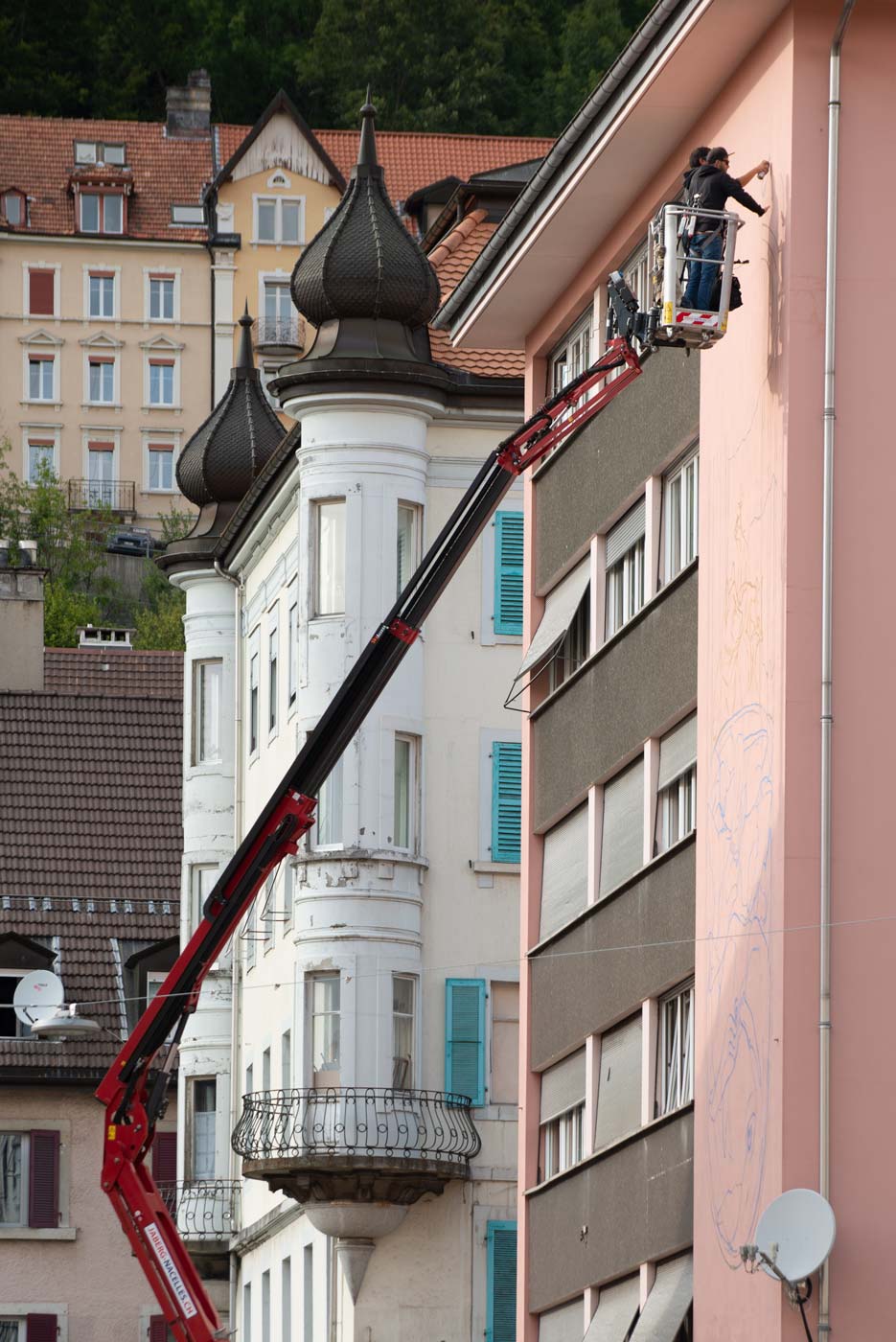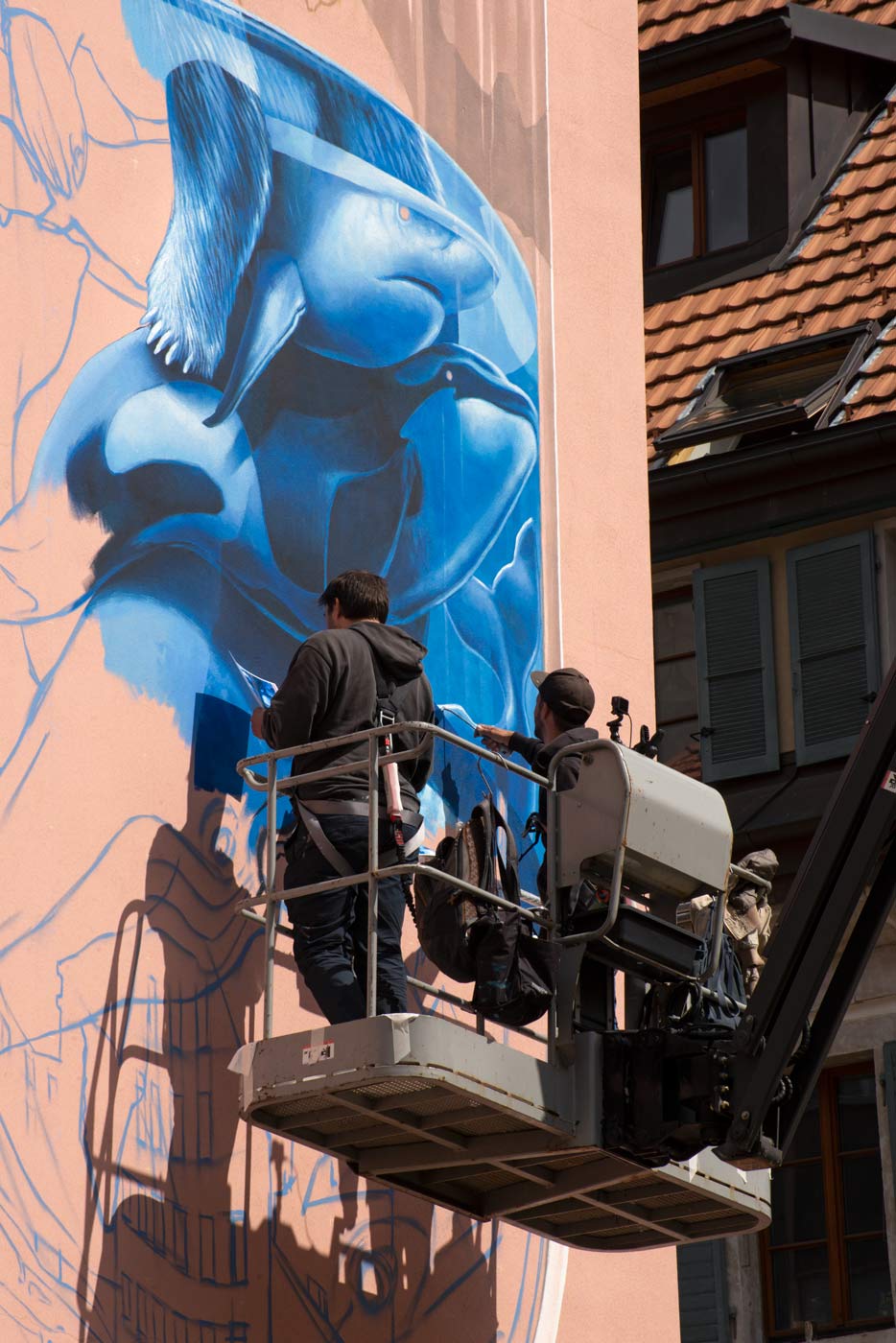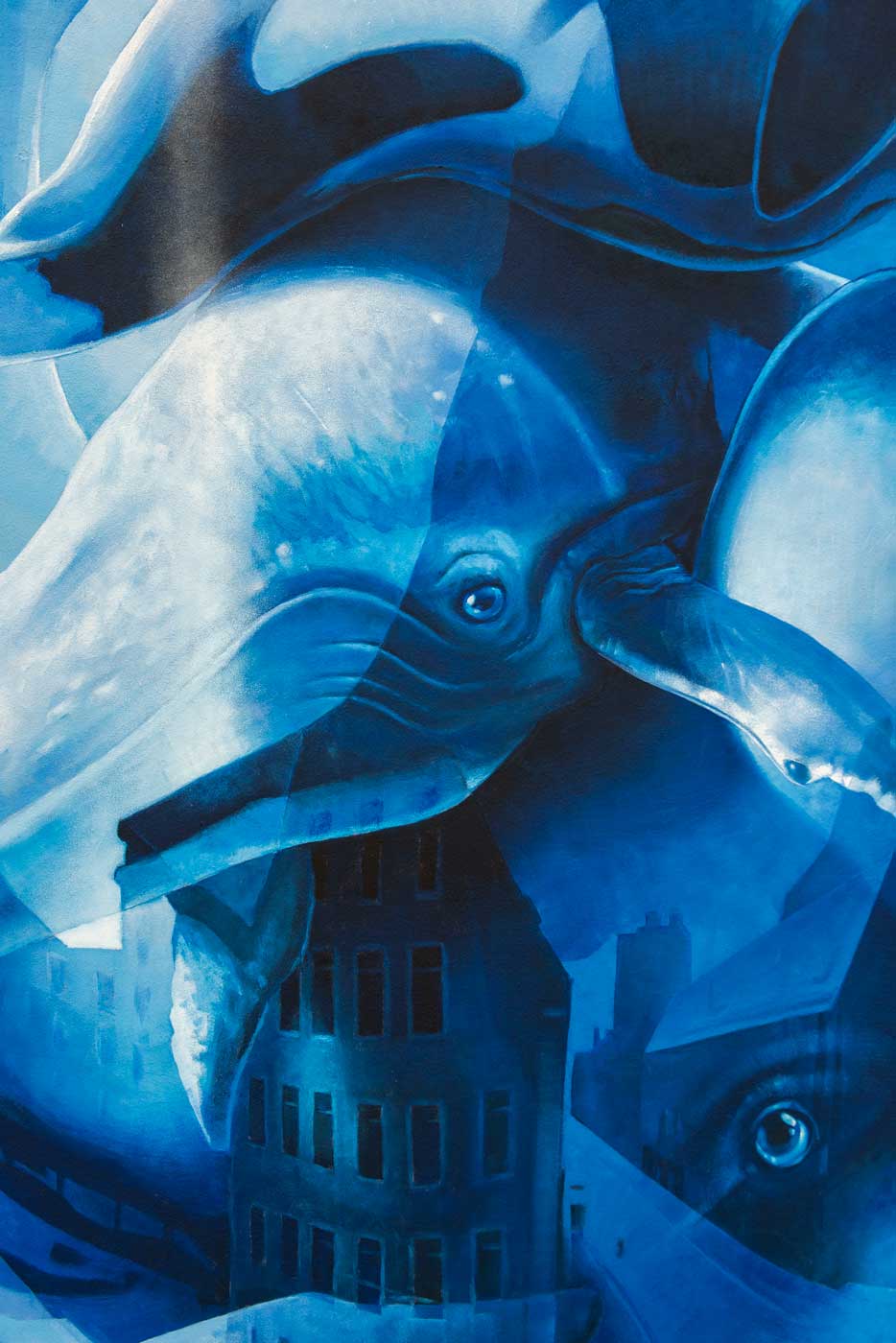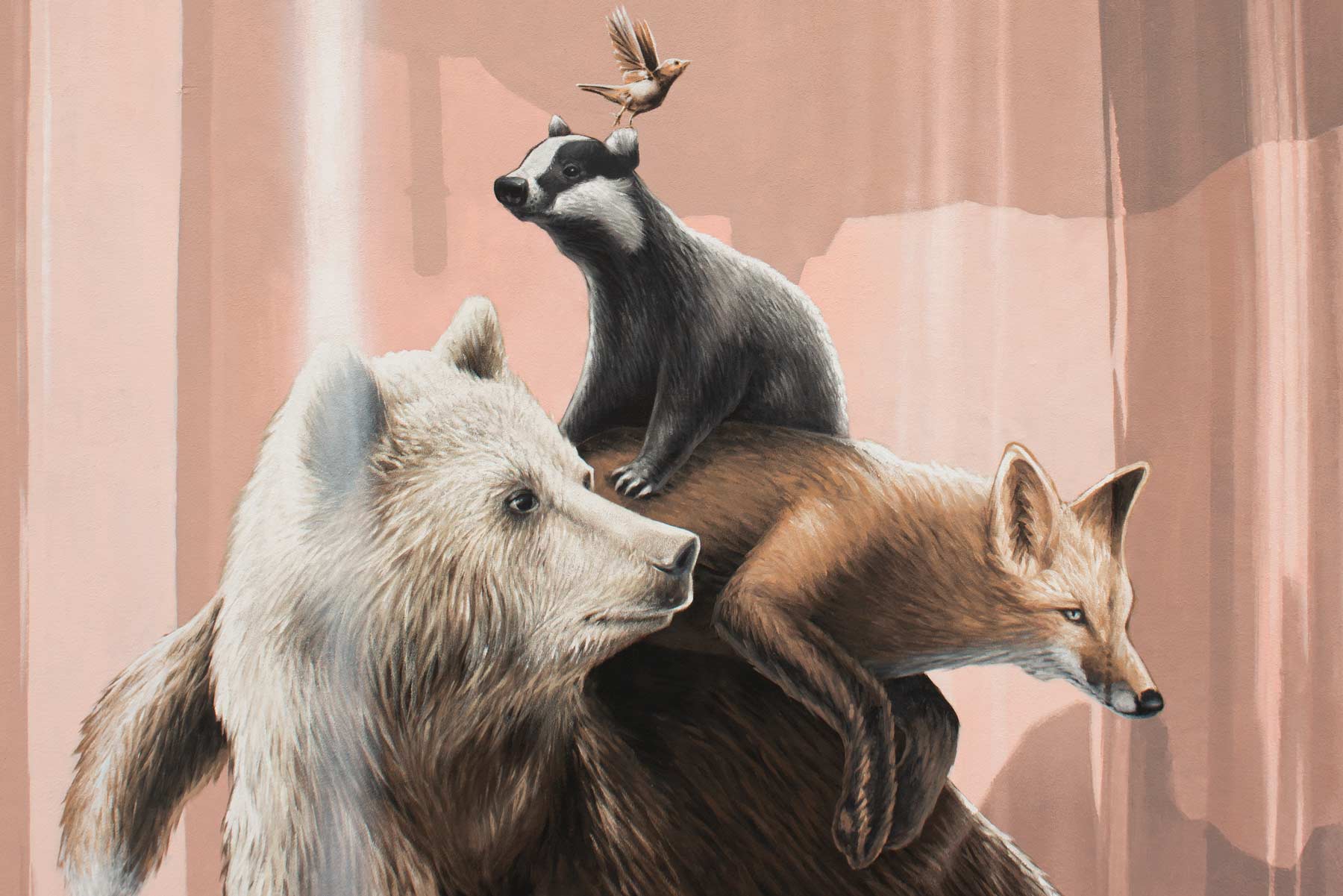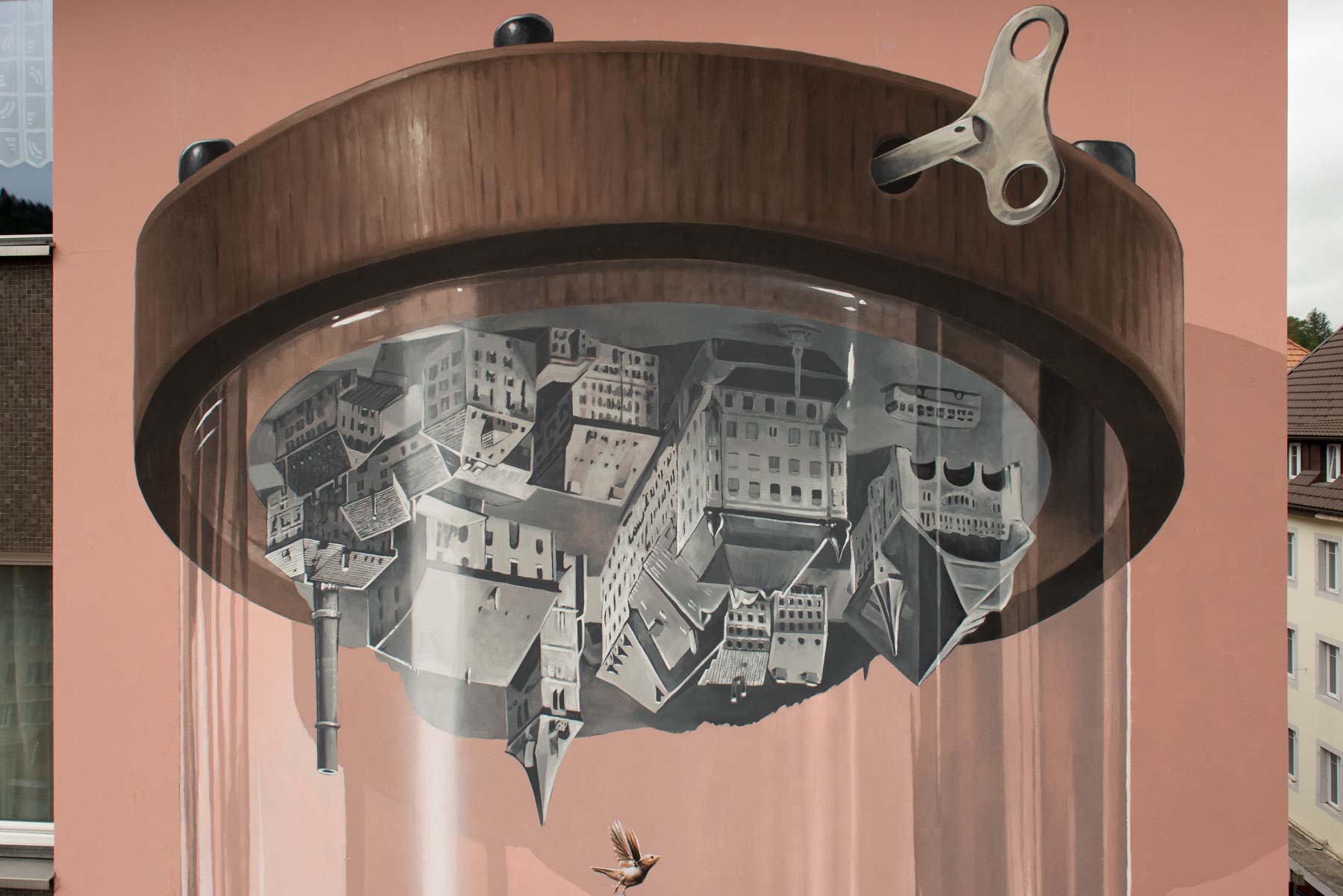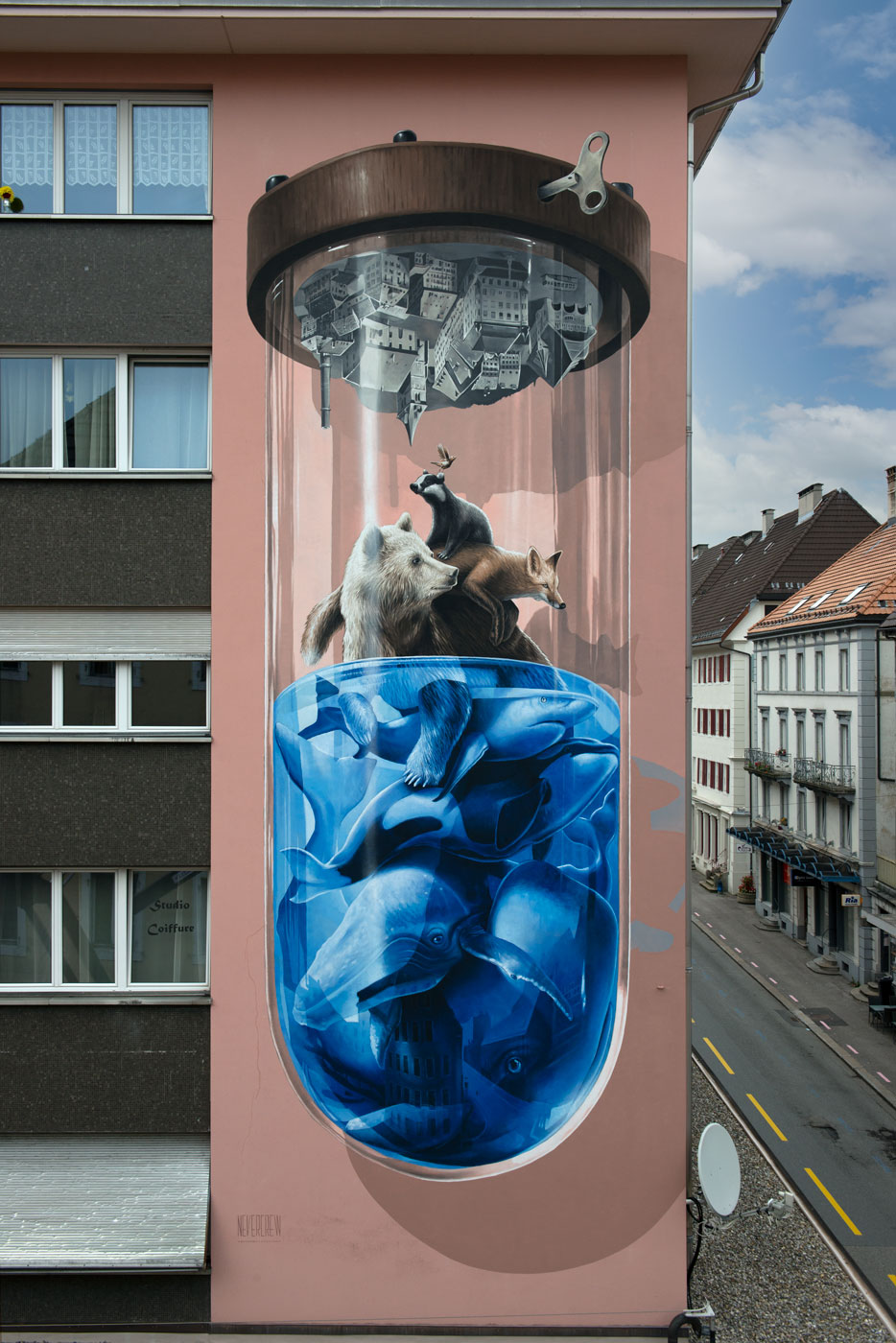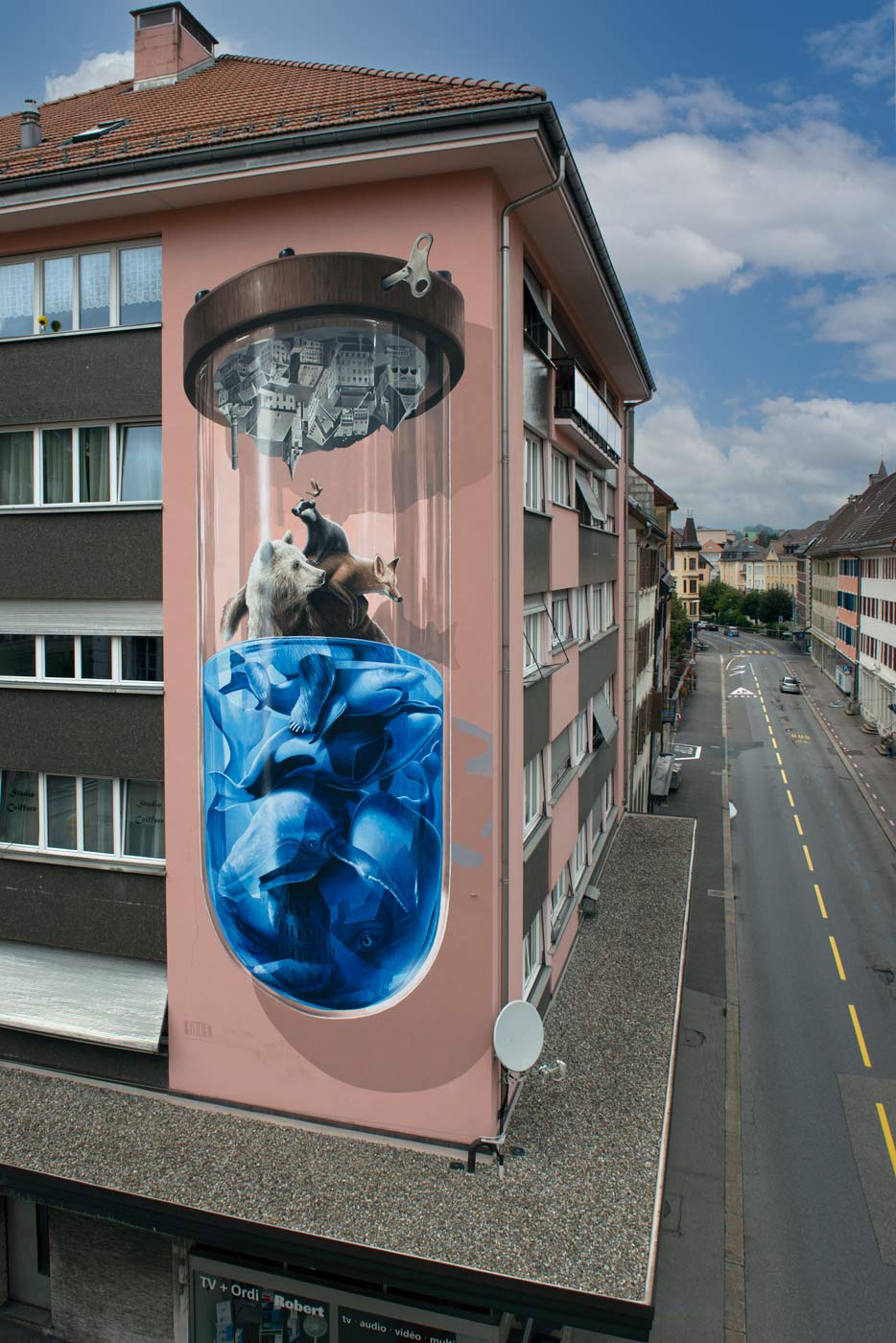Nevercrew
[CH]
- THE WORK -
Gravity
TITLE: GRAVITY
Technique: PAINTING (BRUSH) AND STENCILS
YEAR CREATED: 2021
LOCATION: JUNCTION OF RUE DU PONT AND RUE DANIEL-JEANRICHARD
SURFACE AREA: 50 m2
Explanations and analyses of the works are provided during guided tours. >>> link to the registration form
When you consider the state of the planet, is your glass half full or half empty? In this mural entitled “Gravity” depicting a half-empty “snow globe”, Christian Rebecchi and Pablo Togni from Ticino, alias NEVERCREW, illustrate the consequences, both direct and indirect, of climate change. Legends on the street art scene in Switzerland, the pair are among the most highly rated Swiss street artists in the world.
Made from glass or transparent plastic, a “snow globe” is a dome filled with water that has a base to make it fully watertight. This type of decorative item traditionally contains a miniaturised scene, often wintry because it is covered in white flakes. Mixed with the water, the granules sink to the bottom of the dome after being turned upside down. When the snow globe is put on its base again, the “flakes” gently fall onto the microcosm, dusting it with a “snowy” covering.
A somewhat timeless and entirely inoffensive item, this snow globe, which symbolises our finite planet, is, however, transformed into a death trap for land and aquatic animals who find themselves confined and piled on top of one another. “You can see a sperm whale, a blue whale, a killer whale, a shark, a bear, a fox, a badger and a bird,” clarify the pair.
Snow globes are usually completely filled with water, but the one created by NEVERCREW is half empty. “The precious liquid that was there has been consumed by mankind or has escaped from the container,” explain the artists. And the ‘white gold’ has evaporated. A parable that serves as a reminder of climate reality and the stress that the water system of the Neuchâtel mountains is under, where winters these days nothing like the winters of the past and the area experiences droughts and record temperatures.
On the base of the snow globe, which is upside down, the artists have painted a condensed version of Le Locle’s centre, a selection of houses with recognisable architectural elements, freely arranged and painted with the photographic realism of a traditional photo from the past. Solidly anchored in the ground, the buildings have not fallen to the bottom of the dome. So far, the “mother commune” seems to be defying gravity and the laws of physics.
“When we designed this mural, we were inspired by particular features of Le Locle, such as its political and social history, its geographical and geological position, and its industrial tradition centred on precision mechanics (particularly in watchmaking), an industry that has shaped the city in the last few centuries,” the artists recall.
“On the glass dome, we’ve painted images of local buildings to create an inseparable link between the artwork and its environment, in other words reality.” Like a mise en abyme of time and space. Le Locle of the past, arranged freely at the top of the mural, is not that different from the Le Locle of today, which appears as reflections. “In the same vein, we can also see a link between the local (the depiction of the town of Le Locle) and the global (the selection of animals) in this mural. So there’s a play on proportions and viewpoints that starts from the precise place the viewer’s position) – the town – and the world, and conversely illustrates the causes and effects of each small action on the system as a whole, reminding us of the place each of us has in the big picture,” explain the artists, who say that their mural also questions notions of appropriation and/or sharing.
“What we want to express with this mural is firstly the sense that things are not going in the right direction, in other words that there is an unnatural situation adversely affecting all living beings. A system made by humanity, but not for people, and that is suffering an imbalance with the environment that is its home. Our mural illustrates the distance between human systems and the natural system. This truncated vision that humanity has of nature is translated into actual damage. A distance and a contrast between human economic systems and the natural system worldwide that are definitely evident in its repercussions on the environment, but also in the significant imbalances and disparities in our societies caused by the absence of social justice or an attitude of exploitation,” say Pablo and Christian.
NEVERCREW’s snow globe comes with a virtual set of chimes that are wound up using the small key in the base. If it could be operated, this musical box would definitely play a tune of heart-breaking sadness. But Pablo and Christian are not fatalists. “Ultimately, given that the “dome” was turned upside down by a human hand, we’re leaving it up to humankind – and in particular to those with the power, knowledge and technology – to choose to turn it the right way up again,” say these humanist artists who are dreaming of a better world.
Running perpendicular to the mural, Rue Daniel-Jeanrichard has around 13,000 vehicles driving along it every day, making it one of the busiest roads in Le Locle. It therefore makes complete sense to position a work of art about global warming at this exact spot.
Made from glass or transparent plastic, a “snow globe” is a dome filled with water that has a base to make it fully watertight. This type of decorative item traditionally contains a miniaturised scene, often wintry because it is covered in white flakes. Mixed with the water, the granules sink to the bottom of the dome after being turned upside down. When the snow globe is put on its base again, the “flakes” gently fall onto the microcosm, dusting it with a “snowy” covering.
A somewhat timeless and entirely inoffensive item, this snow globe, which symbolises our finite planet, is, however, transformed into a death trap for land and aquatic animals who find themselves confined and piled on top of one another. “You can see a sperm whale, a blue whale, a killer whale, a shark, a bear, a fox, a badger and a bird,” clarify the pair.
Snow globes are usually completely filled with water, but the one created by NEVERCREW is half empty. “The precious liquid that was there has been consumed by mankind or has escaped from the container,” explain the artists. And the ‘white gold’ has evaporated. A parable that serves as a reminder of climate reality and the stress that the water system of the Neuchâtel mountains is under, where winters these days nothing like the winters of the past and the area experiences droughts and record temperatures.
On the base of the snow globe, which is upside down, the artists have painted a condensed version of Le Locle’s centre, a selection of houses with recognisable architectural elements, freely arranged and painted with the photographic realism of a traditional photo from the past. Solidly anchored in the ground, the buildings have not fallen to the bottom of the dome. So far, the “mother commune” seems to be defying gravity and the laws of physics.
“When we designed this mural, we were inspired by particular features of Le Locle, such as its political and social history, its geographical and geological position, and its industrial tradition centred on precision mechanics (particularly in watchmaking), an industry that has shaped the city in the last few centuries,” the artists recall.
“On the glass dome, we’ve painted images of local buildings to create an inseparable link between the artwork and its environment, in other words reality.” Like a mise en abyme of time and space. Le Locle of the past, arranged freely at the top of the mural, is not that different from the Le Locle of today, which appears as reflections. “In the same vein, we can also see a link between the local (the depiction of the town of Le Locle) and the global (the selection of animals) in this mural. So there’s a play on proportions and viewpoints that starts from the precise place the viewer’s position) – the town – and the world, and conversely illustrates the causes and effects of each small action on the system as a whole, reminding us of the place each of us has in the big picture,” explain the artists, who say that their mural also questions notions of appropriation and/or sharing.
“What we want to express with this mural is firstly the sense that things are not going in the right direction, in other words that there is an unnatural situation adversely affecting all living beings. A system made by humanity, but not for people, and that is suffering an imbalance with the environment that is its home. Our mural illustrates the distance between human systems and the natural system. This truncated vision that humanity has of nature is translated into actual damage. A distance and a contrast between human economic systems and the natural system worldwide that are definitely evident in its repercussions on the environment, but also in the significant imbalances and disparities in our societies caused by the absence of social justice or an attitude of exploitation,” say Pablo and Christian.
NEVERCREW’s snow globe comes with a virtual set of chimes that are wound up using the small key in the base. If it could be operated, this musical box would definitely play a tune of heart-breaking sadness. But Pablo and Christian are not fatalists. “Ultimately, given that the “dome” was turned upside down by a human hand, we’re leaving it up to humankind – and in particular to those with the power, knowledge and technology – to choose to turn it the right way up again,” say these humanist artists who are dreaming of a better world.
Running perpendicular to the mural, Rue Daniel-Jeanrichard has around 13,000 vehicles driving along it every day, making it one of the busiest roads in Le Locle. It therefore makes complete sense to position a work of art about global warming at this exact spot.
© exomusée – January 2022 – Redaction: François Balmer – Translation: Proverb, Heiler & Co
JUNCTION OF RUE DU PONT AND RUE DANIEL-JEANRICHARD
- THE ARTISTS -
Christian Rebecchi & Pablo Togni
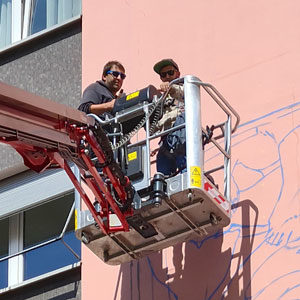
Since 1996, NEVERCREW’s work has focused on the relationship between man and nature, and the impact human activities have on the environment. The collective is also keen to denounce social injustices and oppressive systems, whether against humans or animals.
Former students of the art school in Lugano, which is where they met, Christian Rebecchi and Pablo Togni have been interacting in public spaces for more than 25 years. They trained at the Accademia di Belle Arti di Brera in Milan before going on to produce works in cities such as Grenoble, New Delhi, Miami, Manchester and Cairo. Named artists of the year in 2012 by the Bally Cultural Foundation, in 2015 Graffiti Art Magazine listed them among the top hundred most influential urban artists.
Their style is visually and technically hybrid. Their visual alchemy is based on combining simple graphic structures and complex hyperrealist elements, confronting two-dimensional and sculptural installations, breaking down different spatial planes and comparing scales.
When the pair work in a place, their approach is not to create a simple mural, but to interact with the urban space.
In their works, natural and artificial elements are forced to find an equilibrium: living and inanimate elements, mechanical, biological, material or animal elements have to live side by side.
Former students of the art school in Lugano, which is where they met, Christian Rebecchi and Pablo Togni have been interacting in public spaces for more than 25 years. They trained at the Accademia di Belle Arti di Brera in Milan before going on to produce works in cities such as Grenoble, New Delhi, Miami, Manchester and Cairo. Named artists of the year in 2012 by the Bally Cultural Foundation, in 2015 Graffiti Art Magazine listed them among the top hundred most influential urban artists.
Their style is visually and technically hybrid. Their visual alchemy is based on combining simple graphic structures and complex hyperrealist elements, confronting two-dimensional and sculptural installations, breaking down different spatial planes and comparing scales.
When the pair work in a place, their approach is not to create a simple mural, but to interact with the urban space.
In their works, natural and artificial elements are forced to find an equilibrium: living and inanimate elements, mechanical, biological, material or animal elements have to live side by side.
© exomusée – January 2022 – Redaction: François Balmer – Translation: Proverb, Heiler & Co
To print the content of the page, please click on the printer icon.
- The exo -
on the web
Thank you for following and supporting the exomusée on Facebook, Instagram and YouTube!
